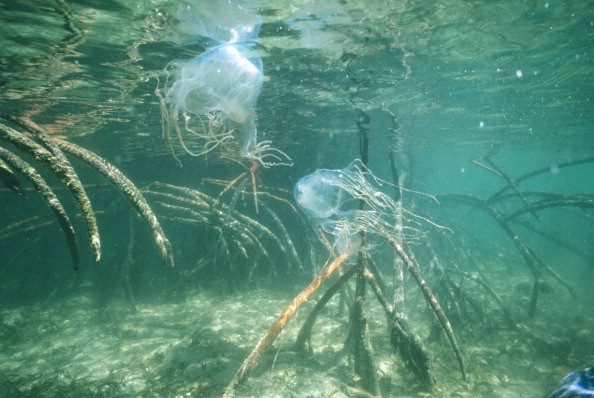A researcher seeking to identify a mystery box jellyfish seen in Sydney waters believes it may be a different species completely.
Appearing Out of Nowhere

The jellyfish's appearance outside of tropical waters has prompted advice on treating marine stings properly.
Scott Belcher, a Sydney resident, had two encounters with the jellyfish on camera. He first observed it a fortnight ago during a group water swim near Cronulla's Shark Island.
"We swam a bit farther south to Shelly beach and came across what I thought was an enormous jimble," he explained, "but after watching it, we realized it's much meaner."
The jimble, Carybdea rastoni, is a box jellyfish species with just four tentacles that may sting painfully but not fatally.
Also Read: Study Showed that Flying Insect Population Decreased by 60% Since 2004
Resembling Australian Box Jellies
The new species resembled the deadly Australian box jelly, Chironex fleckeri, also known as the sea wasp, with several tentacles around 30cm long.
"The jellyfish's head was roughly the size of your hand," Belcher remarked.
Six days later, he videotaped another encounter with what appears to be a second jellyfish of the same species.
"It's incredible that I was at the right place at the right time with my camera functioning."
According to Dr. Lisa-ann Gershwin, the Cronulla specimens might belong to a new species, a jellyfish researcher in Hobart.
"It's not Chironex fleckeri, the box jellyfish," Gershwin said.
"However, it's a box-shaped jellyfish linked to Chironex." "That doesn't belong in Sydney," I thought at first.
She collaborates with the Australian Museum to identify the species, which she claims is similar to an unexplained specimen stored in the museum's collection since 1984.
Other Sightings

Another hypothesis is that the sightings in Cronulla were bigger individuals of Chiropsella saxoni, a 3cm pygmy box jellyfish found in Queensland and described as a new species by Gershwin in 2015.
Gershwin said it was impossible to tell whether the new jellyfish was poisonous since it possessed characteristics of both non-dangerous jellyfish and the world's most venomous marine critter, the Australian box jelly.
"In my experience researching the world's box-shaped jellies, all of the ones with thick tentacles are hazardous, and all of those without thick tentacles aren't," she added. "The issue is that the ones from Cronulla have large tentacles."
Other structural aspects of the new jellyfish, such as spherical gastric saccules - "little gelatinous knobs on the interior of the body" - mirror those of non-dangerous species.
According to Gershwin, there have been sporadic sightings of lethal Australian box jellies in New South Wales during the last several decades, but no film or recovered specimens.
"Any jellyfish that stings someone outside of the tropics is thought to be a bluebottle," she explained.
"Most people are unaware that an Irukandji [the species Morbakka fenneri, which Gershwin described in 2008] endemic to NSW has been stinging people... since 1905," says Gershwin.
Out of Its Place
Outside of tropical climates, the Australian Resuscitation Council suggests thoroughly cleaning the sting with seawater and treating the discomfort with hot water or ice. Gershwin described it as "standard and proper therapy," emphasizing the significance of first cleaning the sting with seawater.
She cautioned avoiding treating suspected box jellyfish stings with hot water right away. "Freshwater causes stinging cells to release, increasing venom load, while heat dilates capillaries, thus opening the floodgates for the venom to circulate."
According to Gershwin, a good rule of thumb for jellyfish stings is to look for bluebottles in armadas.
"If you are stung and get out of the water with no bluebottles all over the beach, the correct presumption is that it's not a bluebottle."
Related Article: Crocodile Population Thrives Due to Feral Pigs
For similar news, don't forget to follow Nature World News!
© 2024 NatureWorldNews.com All rights reserved. Do not reproduce without permission.

![Tsunami Hazard Zones: New US Map Shows Places at Risk of Flooding and Tsunamis Amid Rising Sea Levels [NOAA]](https://1471793142.rsc.cdn77.org/data/thumbs/full/70325/280/157/50/40/tsunami-hazard-zones-new-us-map-shows-places-at-risk-of-flooding-and-tsunamis-amid-rising-sea-levels-noaa.jpg)



